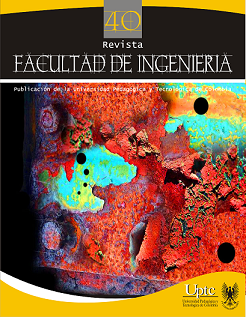Non-destructive techniques in concrete elements for bridges’ evalutation

Abstract
In this work the Non-Destructive Techniques of Ultrasonic Pulse Velocity (UPV), Infrared Thermography and Rebound Hammer, used in concrete bridge elements to determine their applicability in situ, were evaluated. The study was conducted in two phases: the design and development of a concrete bridge representative elements, and their non-destructive testing application.
The UPV technique showed a great capacity to assess the concrete matrix uniformity and quality, with low sensitivity to identify the reinforcements’damages. The infrared thermography allowed to identify delaminations located at depths up to 50% of the evaluated slab thickness. With the rebound hammer results, the concrete slabs compressive strength was estimated, but their readings were affected by the coarse aggregate presence.
Keywords
ultrasonic pulse velocity, infrared thermography, sclerometer, rebound hammer, concrete slabs, delaminations
References
- L. E. Yamin y D. Ruiz, “Vulnerabilidad sísmica de puentes en Colombia y estrategias para rehabilitación”, Revista de Ingeniería Universidad de los Andes, vol. 13, pp. 1-7, May. 2001.
- E. Muñoz, R. Hernández, “Rehabilitación de los puentes de la red de carreteras de Colombia, basados en inspecciones visuales, estudios especializados y estrategias de reparación”, Revista de Ingenieria de Construcción,vol. 20, pp. 159-183, enero, 2005.
- I. Quashie, K. A. Danso, H.C. Odoi, C.A. Adjei et al., “Non-Destructive Evaluation of Concrete using Ultrasonic Pulse Velocity”, Research Journal of Applied Sciences Engineering and Technology, vol. 3, pp.241-251, Jun. 2011.
- J. O. Herrera, R. Cruz y L. Quintero, “Evaluación del efecto de barras de refuerzo en concreto sobre las medidas de velocidad de pulso ultrasónico (VPU)”, Revista Colombiana de Materiales, vol. 5, pp. 107-113, May. 2014.
- B. Milovanovic´ et al., “The Role of Infrared Thermography in Nondestructive Testing of Concrete Structures”, Zagreb SPIN Meeting., vol. 6, pp. 1-6, May. 2012.
- B. Mohammed, N. Juaini y M. Abdullahi, “Evaluation of rubbercrete based on ultrasonic pulse velocity and rebound hammer test”, Construction and Building Materials., vol. 25, pp.1388-1397, Mar. 2011.
- G. Willian, Propuesta de una metodología no destructiva para la inspección de puentes de concreto reforzado en servicio, Bucaramanga: Universidad Industrial de Santander (UIS), 2012.
- L. Jones, “Inspection methods and techniques to determine Non Visible Corrosion of prestress in Strands in Concrete Bridge Components”, Washington: ATLSS, 2011.
- Government of India, Guidelines on nondestructive testing of bridges, LUCKNOW: Research Desings and Standards Organisation, 2009.
- N. Zoidids, E. Tatsis, C. Vlachopoulos et al., “Inspection, evaluation and repair monitoring of cracked concrete floor using NDT methods”, Construction and Building Materials, vol. 48, pp. 1302-1308, Jul. 2013.
- K. Harris, H. Melo et al., “Application of Thermal IR Imagery for concrete bridge inspection”, CEE, vol. 36, pp. 689-704, Nov. 2011.
- N. Kalos, L. Sangwook y S. Hyoung, “Non-Destructive Testing Methods in the U.S. for Bridge Inspection and Maintenance”, KSCE Journal of Civil Engineering, pp. 1322-1331, May. 2014.
- R. Cruz, L. Quintero, E. Espinosa y C. Galán, “Evaluación de ensayos no destructivos para identificar deterioro en puentes de concreto”, Revista Colombiana de Materiales, vol. 5, pp. 55-60, May. 2014.
- Board Trasportation Research, Nondestructive testing to identify concrete bridge deck deterioration, Washington: TRB, 2012.
- T. Sartorti et al.,“Identificación y análisis de patologías en puentes de carreteras urbanas y rurales”, Revista de Ingeniería de Construcción, vol. 26, pp. 5-24,Apr. 2011.
- Universidad Nacional de Colombia - Instituto Nacional de Vías (INVIAS). “Estudio e Investigación del Estado Actual de las Obras de la Red Nacional de Carreteras. Manual para la Inspección Visual de Puentes y Pontones”. Bogotá, 2006.
- S. Guzmán, “Modelización del deterioro de tableros de puentes de hormigón por difusión de cloruros y corrosión de la armadura pasiva”, Madrid: Universidad Politécnica de Madrid, 2010.